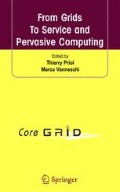Abstract
In this paper we propose a design pattern for self-optimizing classification systems, i.e. classifiers able to adapt their behavior to the system changes. First, we provide a formalization of a self-optimizing classifier we use to derive the design pattern. Then, we describe the pattern classes, their interactions, and validate our approach applying the proposed pattern to a real scenario. Finally, to evaluate the proposed solution we compare the behavior of the self-optimizing classifier with a not self-optimizing one. Experimental results demonstrate the approach effectiveness.
Access this chapter
Tax calculation will be finalised at checkout
Purchases are for personal use only
Preview
Unable to display preview. Download preview PDF.
References
Tarek F. Abdelzaher, Kang G. Shin, and Nina Bhatti. Performance guarantees for Web server end-systems: A control-theoretical approach. IEEE Transactions on Parallel and Distributed Systems, 2002.
Gagan Aggarwal. On identifying stable ways to configure systems. In: ICAC ’04: Pro-ceedings of the First International Conference on Autonomic Computing (ICAC’04), pages 148-153, Washington, DC, USA, 2004. IEEE Computer Society.
Raphael M. Bahati, Michael A. Bauer, and Elvis M. Vieira. Mapping policies into auto-nomic management actions. icas, 0:38, 2006.
Yu-Han Chang, Tracey Ho, and Leslie Pack Kaelbling. Mobilized ad-hoc networks: A reinforcement learning approach. icac, 00:240-247, 2004.
Ira Cohen, Jeffrey S. Chase, Mois és Goldszmidt, Terence Kelly, and Julie Symons. Cor-relating instrumentation data to system states: A building block for automated diagnosis and control. In OSDI, pages 231-244, 2004.
Patrizio Dazzi, Francesco Nidito, and Marco Pasquali. New perspectives in autonomic design patterns for stream-classification-systems. In: WRASQ ’07: Proceedings of the 2007 workshop on Automating service quality, pages 34-37, New York, NY, USA, 2007. ACM.
Y. Diao, J. L. Hellerstein, S. Parekh, and J. P. Bigus. Managing web server performance with autotune agents. IBM Syst. J., 42(1):136-149, 2003.
Alan Fern, Robert Givan, Babak Falsafi, and T. N. Vijaykumar. Dynamic feature selection for hardware prediction. J. Syst. Archit., 52(4):213-234, 2006.
Joseph L. Hellerstein, Fan Zhang, and Perwez Shahabuddin. Characterizing normal op-eration of a web server: Application to workload forecasting and problem determination. In Int. CMG Conference, pages 150-160, 1998.
J. Hillman and I. Warren. An open framework for dynamic reconfiguration. ICSE ’04: Proceedings of the 26th International Conference on Software Engineering, page 594-603,2004.
IBM. Autonomic Computing Initiative. www.ibm.com/autonomic.
Michael Mesnier, Eno Thereska, Gregory R. Ganger, and Daniel Ellard. File classification in self-* storage systems. In: ICAC ’04: Proceedings of the First International Conference on Autonomic Computing (ICAC’04), pages 44-51, Washington, DC, USA, 2004. IEEE Computer Society.
Marco Pasquali, Ranieri Baraglia, Gabriele Capannini, Laura Ricci, and Domenico Laforenza. A two-level scheduler to dynamically schedule a stream of batch jobs in largescale grids. In Proceedings of the 17th HPDC: ACM/IEEE International Symposium on High Performance Distributed Computing, 2008. Accepted as a Poster.
W. E. Walsh, G. Tesauro, J. O. Kephart, and R. Das. Utility functions in autonomic systems. In In Proceedings of the 1st International Conference on Autonomic Computing, May 2004.
Ian Warren, Jing Sun, Sanjev Krishnamohan, and Thiranjith Weerasinghe. An automated formal approach to managing dynamic reconfiguration. In: ASE ’06: Proceedings of the 21st IEEE International Conference on Automated Software Engineering (ASE’06), pages 37-46, Washington, DC, USA, 2006. IEEE Computer Society.
Author information
Authors and Affiliations
Editor information
Editors and Affiliations
Rights and permissions
Copyright information
© 2008 Springer Science+Business Media, LLC
About this chapter
Cite this chapter
Pasquali, M., Dazzi, P., Panciatici, A., Baraglia, R. (2008). Self-Optimizing Classifiers: Formalization And Design Pattern. In: Priol, T., Vanneschi, M. (eds) From Grids to Service and Pervasive Computing. Springer, Boston, MA. https://doi.org/10.1007/978-0-387-09455-7_13
Download citation
DOI: https://doi.org/10.1007/978-0-387-09455-7_13
Publisher Name: Springer, Boston, MA
Print ISBN: 978-0-387-09454-0
Online ISBN: 978-0-387-09455-7
eBook Packages: Computer ScienceComputer Science (R0)

